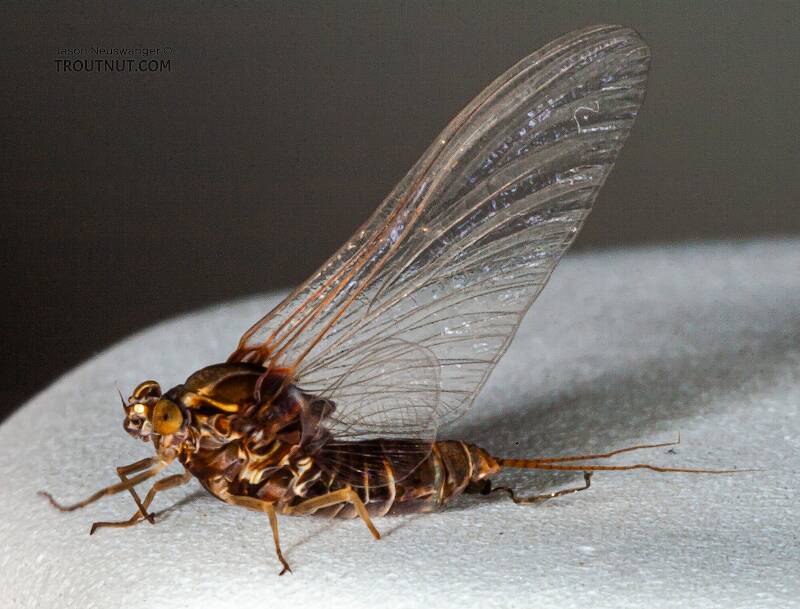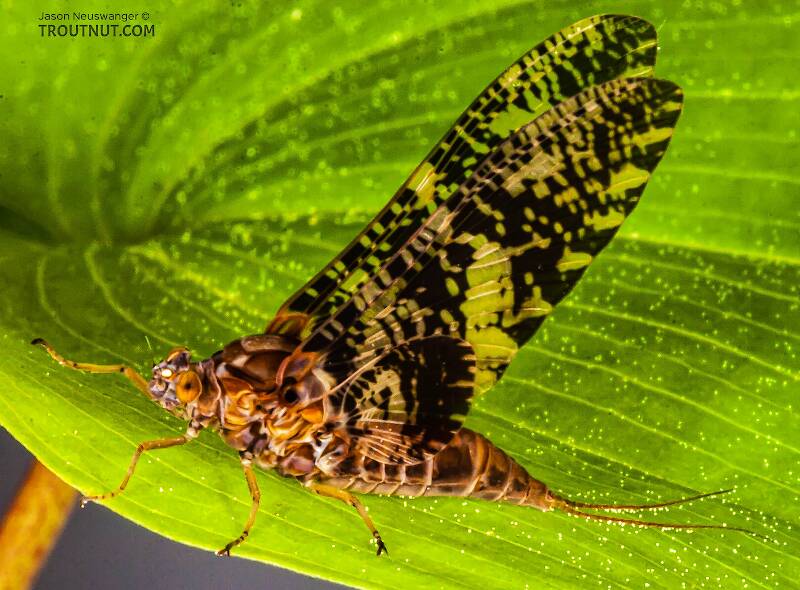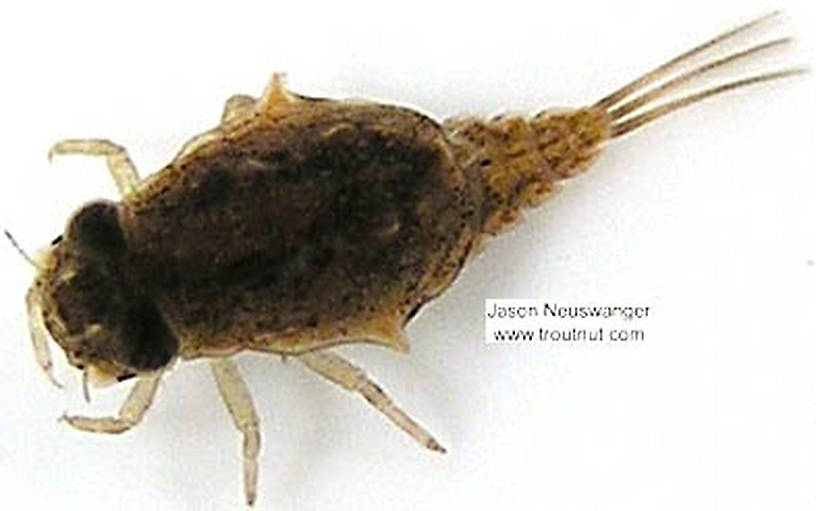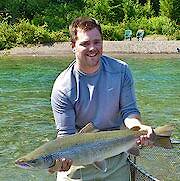
Salmonflies
Pteronarcys californica
The giant Salmonflies of the Western mountains are legendary for their proclivity to elicit consistent dry-fly action and ferocious strikes.
Featured on the forum

I was not fishing, but happened to be at an unrelated social event on a hill above this tiny creek (which I never even saw) when this stonefly flew by me. I assume it came from there. Some key characteristics are tricky to follow, but process of elimination ultimately led me to Sweltsa borealis. It is reassuringly similar to this specimen posted by Bob Newell years ago. It is also so strikingly similar to this nymph from the same river system that I'm comfortable identifying that nymph from this adult. I was especially pleased with the closeup photo of four mites parasitizing this one.

Troutnut is a project started in 2003 by salmonid ecologist Jason "Troutnut" Neuswanger to help anglers and
fly tyers unabashedly embrace the entomological side of the sport. Learn more about Troutnut or
support the project for an enhanced experience here.
This topic is about the Mayfly Species Baetisca laurentina
This Midwestern species is responsible for all my Baetisca fishing experiences. Read the section on the genus Baetisca for most of the details.Example specimens
Troutnut on Jun 26, 2006June 26th, 2006, 4:57 pm EDT
Based on reports from several sources and my own experiences, I'm beginning to think it is significantly more important than it has been credited for. The duns emerge by crawling out onto land, so they aren't important, but some of my most memorable fishing nights of 2005 were due to Baetisca spinner falls.
It is a tricky hatch to detect. I haven't seen more than a couple of their spinners in the air at a time, though some of my friends report spotting their swarms. Normally for me they just showed up on the water from unseen swarms upstream. They were mixed with spinners from Ephemerella invaria and Maccaffertium vicarium, among others, but the fish were relentlessly selective to the Baetisca laurentina spinners.
I wasted the better part of an hour flinging a sulphur imitation the first time I encountered a Baetisca fall. Like Ephemerella spinners, they can be hard to spot on the water, and they were much more sparse. I finally captured one, noticed the very different body profile, and since I didn't have anything remotely imitating it I continued to catch no fish. I returned the next night with an imitation with a robust, opaque body, and the fish went crazy for it.
I just finished reading through the account by Caucci and Nastasi in Hatches II about how the extremely important Ephemerella invaria sulphur species went unnoticed for decades because it was confused with Ephemerella dorothea. The maddening difficulty of some dorothea hatches was partially explained away once people understood this difference.
Although Baetisca is much less prominent than Ephemerella invaria, I suspect it has similarly been confused with well-known sulphur species in the rare locations and occasions where it is important.
It is a tricky hatch to detect. I haven't seen more than a couple of their spinners in the air at a time, though some of my friends report spotting their swarms. Normally for me they just showed up on the water from unseen swarms upstream. They were mixed with spinners from Ephemerella invaria and Maccaffertium vicarium, among others, but the fish were relentlessly selective to the Baetisca laurentina spinners.
I wasted the better part of an hour flinging a sulphur imitation the first time I encountered a Baetisca fall. Like Ephemerella spinners, they can be hard to spot on the water, and they were much more sparse. I finally captured one, noticed the very different body profile, and since I didn't have anything remotely imitating it I continued to catch no fish. I returned the next night with an imitation with a robust, opaque body, and the fish went crazy for it.
I just finished reading through the account by Caucci and Nastasi in Hatches II about how the extremely important Ephemerella invaria sulphur species went unnoticed for decades because it was confused with Ephemerella dorothea. The maddening difficulty of some dorothea hatches was partially explained away once people understood this difference.
Although Baetisca is much less prominent than Ephemerella invaria, I suspect it has similarly been confused with well-known sulphur species in the rare locations and occasions where it is important.
Jason Neuswanger, Ph.D.
Troutnut and salmonid ecologist
Troutnut and salmonid ecologist
Entoman on Apr 5, 2013April 5th, 2013, 9:19 pm EDT
Another example of the benefits this site provides by linking older related topics. This one illustrates great practical observations and insight into the reasons why the "wrong fly" is often the "right answer." Too bad the topic never took off.
We often get wrapped up in how trout perceive certain creatures assuming that's the one they are responding to. I've had anglers tell me that thin bodies and wings aren't all that important because they caught fish on patterns that looked nothing like the spinners or duns they saw in the air at last light...
We often get wrapped up in how trout perceive certain creatures assuming that's the one they are responding to. I've had anglers tell me that thin bodies and wings aren't all that important because they caught fish on patterns that looked nothing like the spinners or duns they saw in the air at last light...
"It's not that I find fishing so important, it's just that I find all other endeavors of Man equally unimportant... And not nearly as much fun!" Robert Traver, Anatomy of a Fisherman
Willy on Apr 8, 2013April 8th, 2013, 7:07 pm EDT
I ran into a baetisca spinner fall on a mid-June morning in Michigan last summer. The fish weren't touching them, but they were eating something else ;)
I'm usually sleeping at that time since I'm fishing late into the night, so it was quite a surprise to see so many bugs on the water. I've heard from others that the fish do occasionally get on them.
My only other experience with baetiscas was on a late-May evening on the Battenkill 8 or 9 years ago. Didn't have the right fly, and couldn't catch a damn thing.
I'm usually sleeping at that time since I'm fishing late into the night, so it was quite a surprise to see so many bugs on the water. I've heard from others that the fish do occasionally get on them.
My only other experience with baetiscas was on a late-May evening on the Battenkill 8 or 9 years ago. Didn't have the right fly, and couldn't catch a damn thing.
Check out my fishing pictures on Instagram.
Quick Reply
Related Discussions
Topic
Replies
Last Reply
2
Jul 9, 2018
by Martinlf
by Martinlf
0
Jun 12, 2006
by Troutnut
by Troutnut
5
Aug 12, 2007
by Wbranch
by Wbranch
6
Nov 12, 2006
by Martinlf
by Martinlf







